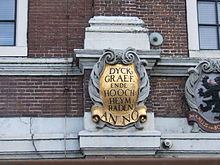Dijkgraaf (official)

A dijkgraaf (lit. 'dike-warden, dike-reeve'), sometimes called a watergraaf, is the chair of a Dutch water board. The dijkgraaf is the equivalent of a mayor in local government and a King's Commissioner in provincial government, chairing both the legislative and executive council, while having both ceremonial and representational roles as well as their own portfolios. The term goes back to pre-medieval days.
Literally the term means "Dike count", like other titles ending in -graaf (equivalent to English: -grave and German: -graf) of feudal origin, but remained a functional official. The government bodies in the Netherlands today in order of rank are:
- National
- Provincial
- Municipal
- Water boards.[citation needed]
In medieval times and earlier however, the water boards were the same as municipal, and since it was a country of duchies, the Water board (Waterschap) was in governmental terms the equivalent of a city (Stad), and thus also the highest form of government.
References
- Dijkgraaf definition (Dutch)
- Water Canon[permanent dead link] (English version) website of The Ministry of Transport, Public Works and Water Management
- First female dijkgraaf Joan Leemhuis-Stout (Dutch)
- v
- t
- e
| Province | Municipality | Special municipality |
|
|
|
- Other public bodies
- Borough
- Safety region
- Water board
- Dike-reeve
- Executives
 | This article about government in the Netherlands is a stub. You can help Wikipedia by expanding it. |
- v
- t
- e












